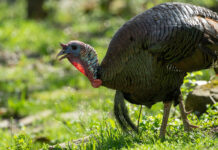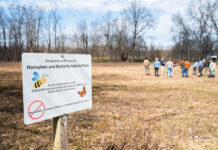Every time a deer wonders into our backyard, my daughter and her Chiweenie go crazy. When the hummingbirds visit, they’re entranced. Bumblebees, butterflies, chipmunks, birds and squirrels captivate their curiosity.
Vayda is so interested in wildlife, she was thrilled to get a squirrel call for Christmas. We actually picked it out jokingly, but to our surprise, she was so excited, she ran out into the yard on Christmas morning to test it out.
We already have a bird feeder and multiple birdhouses. She’s been asking for a bird bath and keeps trying to talk me into a squirrel feeder. Our backyard is destined to be a wildlife oasis. So why not incorporate the same welcoming attitude to our flower beds?
If you enjoy watching wildlife and want to make your yard a destination, your gardening habits are a good place to start.
Planting native plants
If you’re trying to attract local wildlife, incorporating native plant species into your garden is key. The animals around your house are best adapted to, and likely reliant on, the plant varieties that are native to your area. They provide shelter and more productive food sources for local wildlife. Additionally, native plants will probably grow better than ornamentals because they are more suited to the area.
Choosing flowers
There are a few things to consider when selecting native varieties for your garden.
Food for thought. Providing a food source will certainly attract wildlife. Planting a variety of flowers with abundant pollen and nectar will attract a number of pollinators. You can enhance this by providing host plants for feeding butterfly and moth caterpillars. Inadvertently, you will also attract the animals that feed on the larvae of these pollinators. The same concept works for larger wildlife. Planting trees that offer a food source will attract the wildlife that feed off of them or seek shelter within their branches. Find more information on critter-friendly trees, here.
Seasonal planting. The next thing you want to consider is seasonal planting to ensure your grand is blooming throughout the growing season, providing a constant food source.
Diversity. You can attract a wider range of wildlife by choosing plants with many different colors and shapes.
Gardening for specific wildlife. Different wildlife have different needs and habits. If you want to attract a specific variety, you’ll probably need to do some research ahead of time to become more intimately acquainted with that animal’s needs. Check out How to garden for pollinators, How to plant a hummingbird garden and How to create a butterfly garden for gardening tips more specific to those varieties.
Wildlife gardening tips
Plant clusters. Planting clusters instead of individual or alternating plant species make food and shelter easier for wildlife to find. By grouping large patches of shapes and colors together, you’ll have an easier time attracting wildlife and you’ll improve their foraging efficiency.
Pruning. Prune your plants regularly to encourage flower production.
Don’t mind the mess
Mess. Although it may not be preferable, wildlife love a mess. Dead or dying trees are sought out by some animals for shelter and others for food. Butterflies and moths like to be sheltered from the wind by small piles of branches. Nesting bees will seek shelter in hollow twigs, logs with holes, stumps, old rodent burrows and fallen plant material if its laying around. And the list goes on… So consider losing up on your expectations of a tidy garden.
Let the sun in
Many animals rely on the sun to be active, so give them a place to bask. Sunlight will also improve the productivity of your garden. Flowering plants need sunlight to produce nectar.
Water
Just like sources of food and shelter, water sources will attract wildlife out of necessity.
Avoid pesticides
Herbicides and insecticides are dangerous for wildlife. They can be ingested when wildlife come to your garden to feed on plants, insects or nectar. They can also be harmful to native plants, which will ultimately eliminate food sources in your garden.












